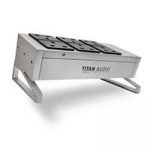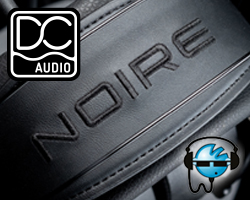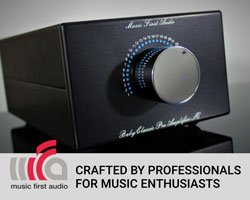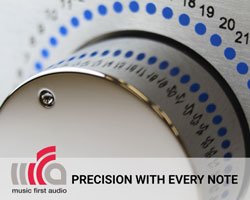TELLURIUM Q BLACK II MAINS CABLES REVIEW
Tellurium Q Black II Mains cable is the latest iteration of the Queen’s Award-winning UK company’s Black mains cable. Janine Elliot tries it out for HiFi Pig.

Quality fittings are the order of the day with the Black II.
Geoff Merrigan can be infuriatingly unhelpful! As Tellurium Q CEO he won’t give anything away as to what is actually inside his cables, rather leaving me to do my job and listen to them and just talk about their sound, which of course is the most important part of any review. Every time I have reviewed TQ award-winning-wires I have been sent both the old version as well as the new Mk II that replaces it and am left to listen to the changes and decide whether the latter is any better. One hopes it always is. This is actually an excellent way of reviewing his products, as it makes me do all the work of evaluating, rather than being influenced by the fact that it uses silver or copper. The Black II might be an improved version of the Black, but it still retains the price of the elder, at £845 for 1.5m.
DESIGN STRATEGY
Geoff’s design strategy is well thought out. For each new product, he spends many hours working out the individual components in his head before physically putting them together and testing them. He has an innate knowledge of materials that dates back to his background as an industrial chemistry student who trained in material science. He has an enviable ability to understand material science which means he can visualise cable configurations so he can listen to cables in his head knowing that they will be good when he finally puts them into production. In the case of the Black II, this took around two years. Certain elements are a no-no and he certainly won’t use silver solder. Similarly, Geoff believes that the temperature at which the solders – the heat time element – can have an effect on the materials and ultimately the sound. Only when the product has been listened to by a number of people does it make its way onto the shelves and the Tellurium Q Matrix System. This is a chart of three series of products; entry-point Blue cables, the Black, and then the top of the range Silver (let’s exclude the “Statement series at the very, very top). Within each “colour” there are several choices, meaning that in terms of increasing level of performance, Blue Diamond, for example, is higher than Silver, though Silver Diamond is tops, just above Black Diamond. Slightly confusing, perhaps, unless you see the chart on the website. Personally, I am very glad he works this way as it is very intuitive.
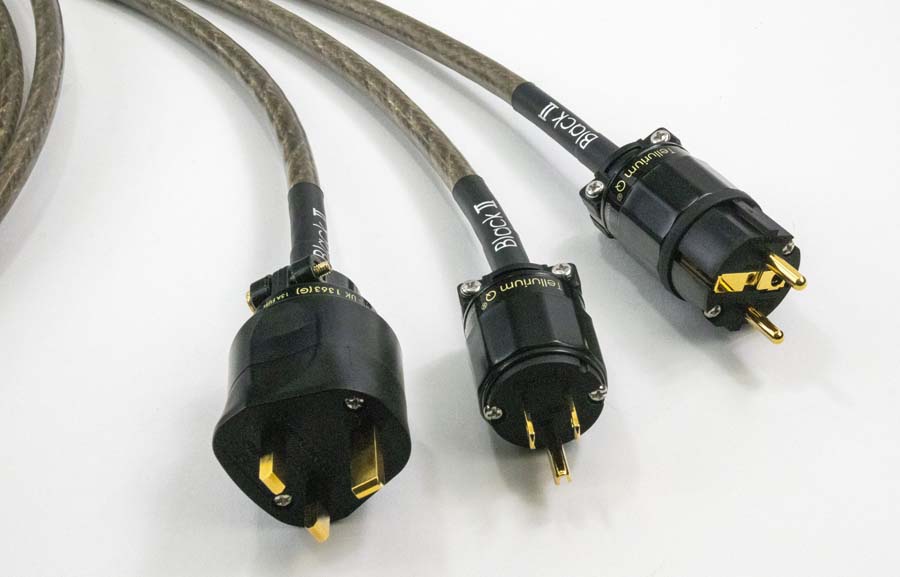
Plugs relevant to your country’s socket are available.
As for the colours themselves, they represent different types of sound strategies for the budding audiophile; the Blue family has a slight warmth that just takes the harsh top edge out of a system; the Black family is a natural/transparent range that allows greater life-like reproduction to simply unlock what the HiFi system can do, and the Silver family is the top-of the range which sounds much clearer and “without the fatigue and harshness that can go along with that material”. Geoff has quite rightly received excellent reviews over the years, including the Queen’s Award for Enterprise in 2018 and again in 2021.
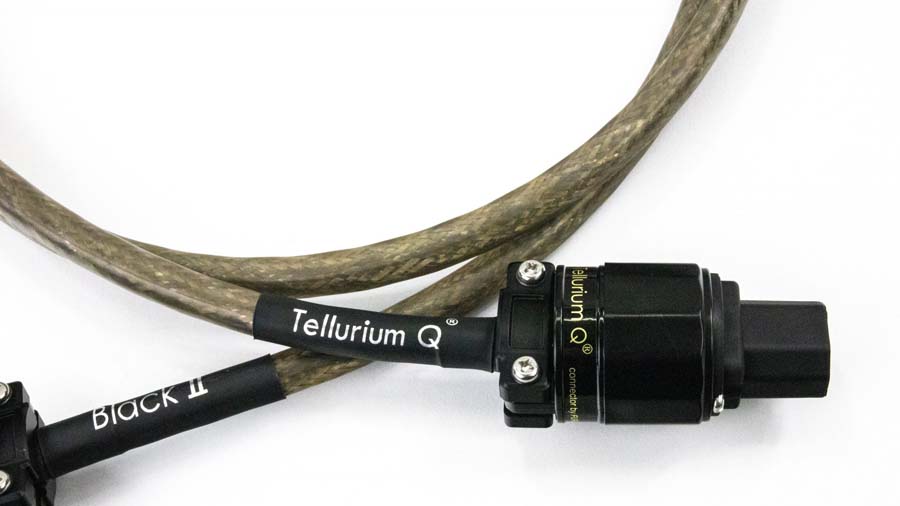
A closer look at the Black II.
BUILD AND FEATURES
Let’s start with the easy bit. The connectors of the Black II are the same as the previous model. That includes the massive gold-plated Furutech FL1363(G) 24k gold plated 3-pin plug at one end and a Tellurium Q socket at the other. The cable is a lighter colour but similar in appearance to the elder. Indeed, as Geoff tells me;
“Apart from the connectors, the only thing that’s the same between the old and new cables is the outer insulating sheath and I have to smile because that is what looks different.”
As for the inside, well, that took a lot more thinking for me. After all, Geoff isn’t one for giving things away. The metal that lies inside is not the only important part, rather it is the sum of the components. And, according to Geoff and many including me, it is the electromagnetic fields, rather than the electrons that carry the energy, so electrons don’t start at one end of the cable and whiz their way down to the other end. Therefore, the geometry and dielectrics are extremely important. Size is also important, but, according to Geoff, not as you might expect.
“I have had people tell me that mains cables need to be great big thick things to be high-performance and audiophile-quality which is simply untrue, but it looks like it might be the case because more is better, right?” Geoff then gave an analogy of an F1 car. It doesn’t have air conditioning or a stereo system, because adding more things adds weight to the car. Similarly, the more you add to a cable the more you potentially change its characteristics and that can actually reduce its function.
“We pare down what is in a cable to better enable performance and choose very carefully what will remain to support its prime functions.”
PHASE RELATIONSHIPS
The USP of TQ cables is ‘phase distortion’, and ultimately reducing it. The Tellurium Q motto is “Phase Relationships in a system is our focus” and the reduction of phase distortion is to create better focus of the music. From the very first cable when Tellurium Q was set up the focus was primarily on the idea of phase distortion and minimising this problem inherent in all cabling, something tackled in different ways by different manufacturers, whether capacitance, inductance, or load impedance. I have been able to sense better phase behaviour in his interconnects and speaker cables, but until this review not in a mains lead. As Geoff explained to me in an earlier review, all materials (not just cables) in the path of a signal will act as an electronic filter, whether you want it to or not. The 1930s report by Bell Labs on the impact on speech from distortion noted that the distorted speech was accompanied by certain audible effects “which appear to be extraneous to the speech and transient in character”. The mains lead is where it all begins so it is vital to have the current that supplies your amplifier behaving at its best.
SOUND QUALITY
Listening to the cable was done in several stages. For a start, I compared the old and new mains lead connected to my Iso Tek EVO3 mains conditioner and then I placed the mains leads separately to CD, phonostage and my Krell poweramp to assess the mains cables one by one (my Synthesis mono-blocks normally in situ would have required two leads, so these amps were only used when the Black II was connected to the EVO3).
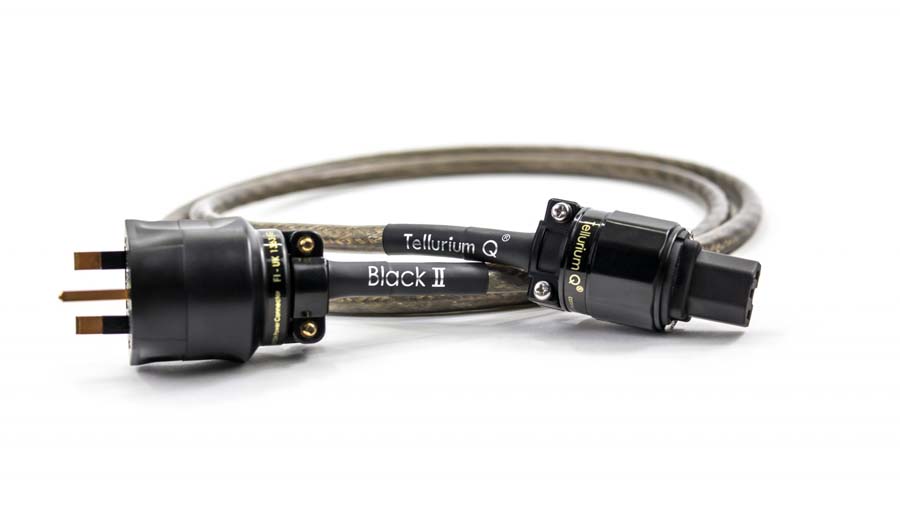
Quality connectors on both ends of Black II.
Listening began with The Moody Blues ‘Caught Live +5’, recorded live at the Royal Albert Hall on December 12th 1969. Although this is an excellently recorded vinyl record, using the original Black mains lead kept the vocals still sounding slightly nasal, and with some distortion from flutes, and a narrow soundstage. The Black II seemed to open it all up more with a more natural vocal. Track 2 has a deep spoken vocal introduction that was even more powerful and clearer; the cable seemed to add more lower bass and the nasal effect was less distinct allowing for greater enjoyment, even in a 1960’s recording. By the way, this album does have some great audience atmosphere and this came across really well, putting to shame some recent live recordings. Maybe the inbuilt phase resolving helped here.
Asia ‘Alpha’ (Steve Howe, guitar) is a similarly very atmospheric album, due to the very OTT reverb. The Black II controlled this significantly better with “Don’t Cry” and “The Smile has Left Your Eyes” keeping me suitably happy, despite the track titles. The positioning of instruments and vocals were kept well-controlled and clearly set out.
Again, more control was had in the Black II for Dire Straits ‘Brothers in Arms’ with a broader soundstage. The slight tizzyness of the left-hand channel in “Money For Nothing” was notably reduced and the music more controlled. I felt the interplay between left and right was clearer. Interestingly, on my meter, the Black II was slightly louder, and this seemed to be apparent on a few tracks I played, though the MFA pre-amp volume control wasn’t adjusted at all for the review. I also found with this and all other music that I played that I was listening more intently, with the music sounding more realistic. How could this be from a mains cable? Even I was impressed. The better phasing seemed to help, I’m sure. Just as temperatures outside my house hit zero, I Listened to Katie Melua ‘In Winter’, and the quiet opening seemed even quieter, showing perhaps some good RFI characteristics bearing in mind the spaghetti junction of cables behind my HiFi rack. The music seemed more relaxed and gently paced than I was used to, gaining more detail of the music from this suitably snow-coloured LP.
Turning to classical music I decided to try out the Symphonica Productions Mahler 5th Symphony (Symphonica of London, Wyn Morris), an LP that really needs a good system to give it a chance of succeeding. The recording is rather “tizzy” and audibly confused, particularly at the start. This is a busy work and the Black II gave a braver attempt at keeping order, even positioning instruments a little clearer.
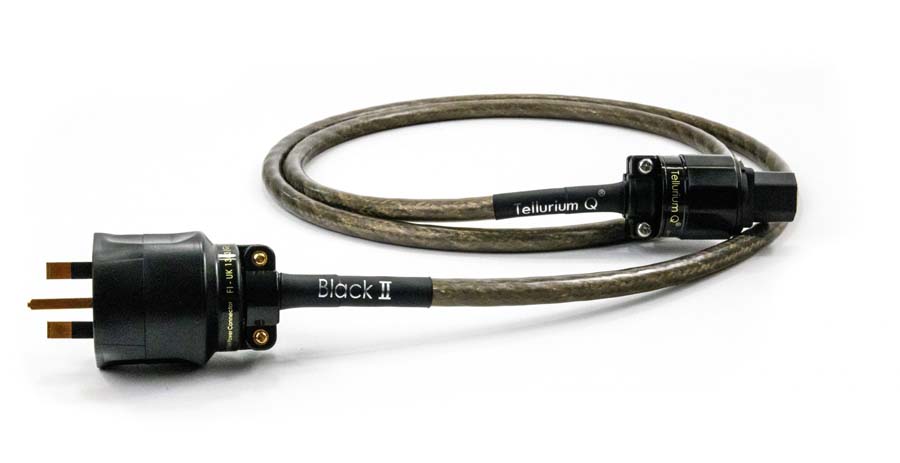
Another angle.
Time for the power lead to be connected to my Krell CD. Compared with the Black cable I found the result was added space and a lower noise floor. Eleanor McEvoy’s ‘Singled Out’ album seemed to have a warmer and more natural midrange and Dean Peer’s “Just Improvise” (guitar and sound effects) had better bass handling and extremely agile transients. Indeed, the latter was something I found in all I played; the timing was precise and accurate.
Harpsichord music from Maria Pimenovio was extremely fast and with better definition at all frequencies. The music was more engaging and dynamic. The power cable allowed me to get the best out of the equipment I had.
CONCLUSION
I didn’t think I would be able to hear much of a difference between the old and new, but I was surprised at just how improved the Black II was, whether it be the speed of transients, improved soundstage or improved lower bass end and it was noticeable with all sources and all music.
The soundscape was better defined, particularly midrange, and most importantly any phasing issues seemed to iron themselves out; reducing any tizzyness in much of the music I played.
Since this retains the same price as the elder, I would certainly recommend a listening session as soon as you can.
AT A GLANCE
Build Quality:
Excellent build using excellent Furutech connectors
Sound Quality:
Improved detail and faster transients than its precursor and with a tighter bass end
Value For Money:
For the same price as its predecessor, this is a much-improved performance so even better value and well worth auditioning
We Loved:
Excellent transients
Greater dynamics
Improved phasing and airiness around instruments
Improved lower-bass
We Didn’t Love So Much:
That Furutech plug is so big!
Price: £845 1.5m
Elevator Pitch Review: According to TelluriumQ boss Geoff Merrigan, there is a whole lot more performance sat unused in people’s systems than they realise. His aim is to eke out the very best of the equipment, something I have in the past witnessed in TQ interconnects and speaker cables. But I didn’t expect a mains cable to improve my listening anywhere as much as it did. Mains leads do make a difference, often the forgotten part of the HiFi system.
Review Equipment: Synthesis Roma 98DC and Krell KAV250a (amplification), Music First Audio Baby Reference (pre-amp), Pre-Audio (turntable)/AT33sa (cartridge)/Manley Steelhead (Phono-stage), Krell KPS20i (CD), Ferrograph Logic7 15ips/½ track (Reel to reel), Tellurium Q, Ecosse and Townshend (cables).

Janine Elliot















































